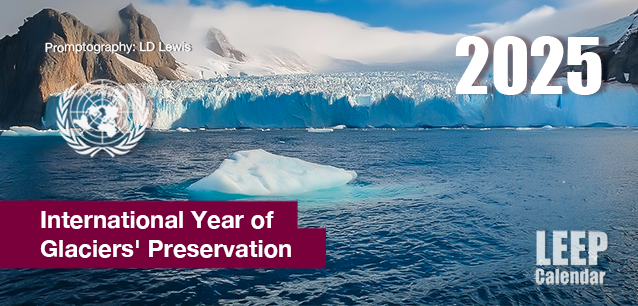 AD
AD
Today is: November 20
Scroll to explore events active on this date.
Additional Events on LEEP
LEEP INK FEATURES

August? Absolutely!
In August, we live through the Dog Days of Summer. It's hot and often humid, and those who can leave for better climates do. Down south, winter is in full force. August is also known as "the ...

In The Heat of July: July 2025 Events
Is it hot enough (or cold enough if you're below the equator) for you yet? There is actually a day for that! Like every month, I pick a diverse collection of events you may or may not know about. This ...

May Blooms: Events in May 2025
Along with October, May is one of the most densely packed months of the year. It's before the summer humidity and the last whole month of the school year. The weather is warming in t...
About the International Year of Glaciers' Preservation
Science & Math , Politics
Ends: Dec 31, 2025
DESCRIPTION:
UNITED NATIONS'
INTERNATIONAL YEAR OF GLACIERS' PRESERVATION
In response to the alarming rate at which glaciers are melting globally, the United Nations declared 2025 the International Year of Glaciers' Preservation. This initiative aims to raise awareness and mobilize action to protect these vital ice formations, crucial for the planet's ecological balance and human well-being.OBJECTIVES
The primary goals of this year-long observance are:
Increase Awareness—Educate the public and policymakers about the importance of glaciers and the urgent need to protect them.
Promote Research—Encourage scientific research to better understand climate change's impacts on glaciers and develop strategies for their preservation.
Support Conservation—Mobilize resources and support for conservation efforts aimed at protecting glaciers and mitigating the effects of their melt.
Foster Collaboration—Enhance international cooperation to address the global challenge of glacier melt and its consequences.UNDERSTANDING GLACIERS
Glaciers are massive, slow-moving rivers of ice formed from compacted layers of snow. Over many years, the weight of accumulated snow compresses and turns into dense ice.
Glaciers form in areas where more snow falls in winter than melts in summer. As snow accumulates, it compresses into ice, and the glacier flows outward under its weight.IMPACT ON LIFE AND ECONOMICS
Water Resources—Glaciers are crucial freshwater reservoirs that supply water to rivers and lakes, especially during dry seasons, and are vital for agriculture, drinking water, and hydropower.
Sea Level Rise—Melting glaciers contribute significantly to rising sea levels, threatening coastal communities and ecosystems.
Climate Regulation—Glaciers reflect sunlight, helping to regulate the Earth's temperature. Their loss accelerates global warming.
Biodiversity—Glacial regions support unique ecosystems and species. Their melt disrupts these habitats, leading to biodiversity loss.
Tourism and Culture—Glaciers attract tourists and hold cultural significance for many indigenous communities. Their degradation impacts local economies and cultural heritage.
The need for the International Year of Glaciers' Preservation is more pressing than ever:
Climate Change—Accelerating climate change is melting glaciers at unprecedented rates, with dire consequences for water resources, sea levels, and global temperatures.
Environmental Impact—The rapid loss of glaciers is disrupting ecosystems, affecting biodiversity, and contributing to natural disasters like floods and landslides.
Human Livelihoods—Millions depend on glaciers for water, agriculture, and energy. Their melt threatens food and water security, especially in vulnerable regions.
Global Awareness—Raising awareness and mobilizing global action are crucial to mitigate these impacts and protect glaciers for future generations.
As the world grapples with the multifaceted challenges of climate change, the International Year of Glaciers' Preservation serves as a crucial call to action. By fostering awareness, promoting research, and encouraging international cooperation, this initiative aims to safeguard glaciers, ensuring they continue to play their vital role in sustaining life and regulating the planet's climate.
VIDEOS
SUPPORTING DOCUMENTS
Currently, this event does not have supporting documents.
ADDITIONAL IMAGES
Currently, this event does not have supporting images.
Where would you like to go now?
 AD
AD


/footer-logo.svg)
